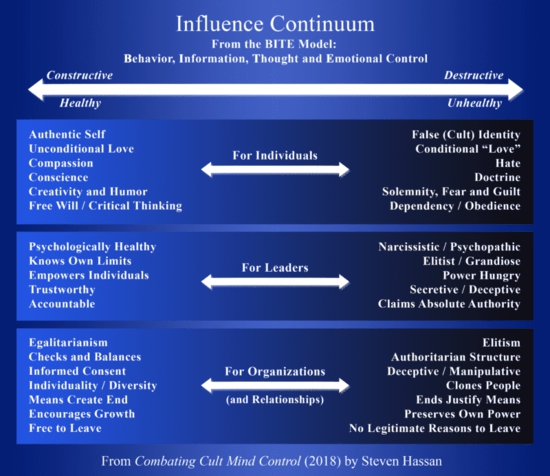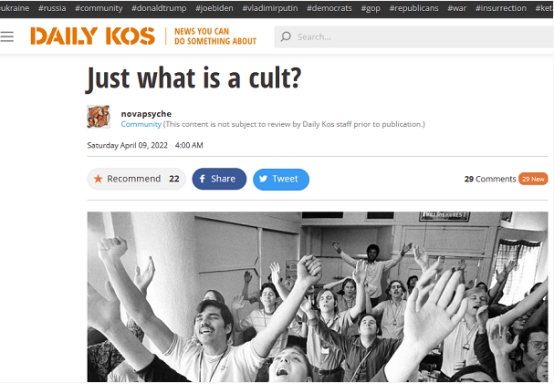
The topic of cults is arising with more frequency, along with brainwashing, referring to one suite of techniques those institutions may use to attract and retain members. Much of the country has reacted with shock, horror or dismay at the text messages exchanged between Ginni Thomas and Mark Meadows regarding Trump’s bogus push to establish a fraud narrative in 2020; we’ve recoiled because the messages unveil both people as true believers, not only of that plot but also in a deeper sense. They both used turns of phrase that betray a membership in QAnon, a melange of religio-political beliefs so extreme and bizarre that it is almost horrifying to find two people so influential in the upper eschelons of government espousing something so cartoonish and yet so fraught with potential violence.
Just this week, video footage of a young Ginni Thomas surfaced where she denounced her involvement in Lifespring, a group she denoted as a cult. There has been some disagreement as to whether Lifespring was so bad as to deserve that appellation. But these were words that Thomas (then Lamb) herself used. Also, from an extraordinary detailed exposé of Lifespring by Marc Fisher of the Washington Post in the mid-1980s, we can see for ourselves that Lifespring satisfies a terrible litany of various aspects of cult behavior.

So what is a cult?
Sociologically speaking, a cult is a group that features intense in-group identification, coalescing generally around a charismatic leader and generally espousing a sense of mission or quest. (In more neutral terms, these sects are also known as “high-intensity groups”.) Their underlying motive could be a mission to change the world or to conquer the inner space of the self. Cults are often depicted in popular understanding as religious, but there are many types of cults: political, financial, psychological (see Symbionese Liberation Army, NXIVM, and Church of Scientology, respectively), and so on. And cults can be of any size, ranging from a cult of two (in the case of folie à deux) up to thousands or even missions.
Cults are often led by a charismatic leader, and indeed this person could be beatific and the group benign or even positive. Many personal self-help high-intensity groups fall into this category. And even if the leader (or leadership structure, as in a tight-knit council) is less than kind, normally the scale of any destruction or misery is held to a minimum, within and among the group members themselves, or their family members tertially. But when the reach of the cult establishes tendrils in the greater society, if that group is headed by someone who has a disordered personality (especially that of malignant narcissism, Machiavellianism, and anti-social tendencies, a combo known as the Dark Triad), there is much potential for any fallout to reach extraordinary proportions. Look at Waco. Witness Jonestown.

A cult operates on deception. According to Janja Lalich, a sociologist who herself was in a left-wing political cult in the 1970s, says that the deception is one of the main distinguishing characteristics of a cult. The recruit is enticed with utopic ideas, though in the end he or she is exhorted to give up their time and money in service to the group. Most people, Lalich explains, would not have joined those groups had they been able to make an informed decision. Instead, those costs are often hidden at the point of recruitment, where what is emphasized is the possibility of extraordinary personal or societal change, buttressed by psychological techniques such as love bombing to get the recruit to stay.
A destructive cult uses many of these psychological techniques to ensnare and retain their members. Many recruits are at transitional phases in their lives and are in search of a sense of belonging or purpose. Those particularly vulnerable to recruitment include those persons suffering a loss (of a loved one, a job, some other trauma or extreme stress) or those who are in the process of moving from one point in life to another. Late adolescence is a common cultural pass-point where the person may be particularly susceptible: not only are they still “finding themselves” in terms of identity, not only are their brains still developing and maturing one of the most important regions (the prefrontal cortex), but also these young people are at this time striking out into the world, separating from their parents or home base for the first time. Divorcees and widow(er)s are also known quantities for cult recruiters. (Indeed, in Lifespring in the ‘80s, Fisher found that half of their membership were singletons or divorcees.)
A common misconception is that the people who join cults must be defective or unusually naive or soft-headed to fall victim to these organizations. This simply isn’t true. While certainly there exists folks who are more susceptible to suggestion and other forms of persuasion, being able to be influenced is a part of human nature as we are social beings. The novelty of the situation, too, can be psychologically disarming, and the love-bombing peer pressure can subtly convince people to go with the flow at first, especially if the initial experiences are pleasant, exciting, or euphoric.
Another point that Robert Jay Lifton, Steven Hassan, and other cult experts have made is that cult leaders don’t want “weak” followers. They want productive, otherwise healthy members, those who have money and time as resources to devote to the group. They don’t want unstable or unpredictable converts, people that they can’t control.
Lifton, one of the pioneers in the discipline of this subset of sociological study,identified eight aspects of what he termed thought reform. Many cults utilize these techniques, and indeed dictators and tyrants throughout the centuries have imposed these forms of totalism on entire populaces:
1. Milieu control: control of communication within the group environment resulting in a significant degree of isolation
2. Mystical manipulation: the claim of divine authority or spiritual advancement that allows leaders to reinterpret events as he or she wishes
3. Demand for purity: world is black and white, either/or, and members are constantly exhorted to strive for perfection
4. Cult of confession: sins, as defined by the group, are to be confessed, either privately to a personal monitor or publicaly to the group at large
5. Sacred science: the doctrine of the group is considered the ultimate Truth, beyond all questioning or disputing; the leader is seen as the earthly spokesperson for God
6. Loading the language: the group develops a jargon often unintelligible to outsiders, words and phrases that seem inspiring but in actuality serve to dull critical thinking
7. Doctrine over person: contrary personal experiences must be denied or re-interpreted to fit the doctrine of the group; the doctrine is always more important than the individual
8. Dispensing of existence: the group arrogates to itself the perogative to decide who has the right to exist and who does not

Steven Hassan, who recently appeared on Ari Melber’s The Beat to discuss Ginni Thomas’ previous anti-cult advocacy (he met her personally as they both spoke on behalf of CAN), for his part developed what he calls the BITE model of coercion.
Here he divides traits of the group along a continuum. The more coercive the group as it falls along this spectrum, the more likely the group is destructive. B stands for behavioral control; I for information control; T for thought control (via restrictive techniques); and E for emotion control. If a group is coercive on all four axes of manipulation, the member is at great risk of being totalized, with a corresponding loss of individual identity and psychological freedom.
Cults often convince their converts to stay, if that person later starts having doubts or misgivings, by utilizing fear, guilt, or even shame. Fear can be stirred in the recruit by telling him or her that some danger will befall them if they leave. Often they are told they will develop a deadly disease such as cancer, get into an auto accident, or encounter death in some other way. If the group is one with a societal vision or is anticipating the end of the world, the convert might be subjected to guilt sessions or other forms of belittlement with accusations of betrayal and abandonment. Lastly, if the group has utilized confession or similar forms of personal information gleaning, or if they have enticed or otherwise encouraged the recruit to participate in compromising hazing rituals, these can be used against him or her as weays of leveraging the humiliation that person would feel if that information were to become public. This is emotional blackmail.
If the convert does manage to break away, often the remaining members will continue to reach out and contact the person to bring them back into the fold. (This is what happened to Ginni Thomas after she left Lifespring, according to her own testimony.) Alternatively, some groups will completely shun or excommunicate the apostate, effectively shielding the remaining members from someone in the best position to offer criticisms about the group. Excommunication can be seen as a self-protective measure, especially from the point of view of the group’s leader. Most cult leaders do not like criticism and do not take kindly to their members leaving of their own volition.
But it’s important to keep in mind that the recruit joins the high-intensity group for a reason. Often that reason is utopic: they may want to change the world. (Indeed, many groups throughout history, such as the U.S. civil rights movement in the 1960s, have managed to do just that; and this can be achieved particularly when the leader is a visionary and not malignant in personality.) Or they may simply be seeking a place of belonging. Cults are the ultimate in-group, emphasizing a clear line of us, thus creating a them. This demarcation can help foster, authentically or artificially, a sense of identity. Especially when this identity is tied to a group and enhanced through intense bonding techniques, this engenders a fierce sense of devotion. The recruit sees the group as something precious and something to protect. It is at this point, where the person’s identity submerges with the group, that the person is most susceptible to radicalization and conversion to extreme beliefs.
Again, too, it is instructive to recall the sensations the convert experiences. They’re love-bombed by those already in the group. The novelty of the whole situation can be intoxicating. The mission provides a sense of purpose. And many of the bonding exercises (meditation, singing, breathing exercises [which may lead to hyperventilation], chanting, dancing, speaking in tongues [known as glossolalia], immersion in heat, water or cold, etc.) evoke physical sensations of euphoria and transcendence. These experiences exert tremendous effect on the brain, especially in terms of affecting neurochemistry. These can all trigger the reward center in the brain, releasing dopamine, serotonin, oxytocin (the “bonding” chemical) and other molecules, creating an overwhelming rush, which is then associated strongly with the group.
Also, the cult member upon conversion has entered into a symbiotic relationship with the leader. The head of the organization is often the pinnacle of a pyramid, and the power dynamic is top-down while responsibilities are bottom-up. This structure in inherently one of domination (which, if the leader is predatory, facilitates opportunities of exploitation); the followers are thus encouraged—often explicitly exhorted—to sacrifice, surrender, or devote. It is this dynamic that can lead the follower to idolize, adulate, and adopt the features of the leader. If the leader is psychopathic or otherwise malign, the follower is at great risk of incorporating these traits.
Resistance
The best methods of protection against cults are:
1. Skepticism.
2. Research.
3. Remaining connected to loved ones and long-standing friends and associates.
4. Maintaining one’s own personal hobbies and pursuits.
5. Trusting that gut feeling of misgiving. If something tells you or urges you to get away, that something is just not quite right, even if you cannot fully articulate that feeling, that is your brain telling you to be wary, that there may be danger. While in some cases this may be overactive fear, it is important to honor that sensation, as nonverbal warnings may be the only way your brain can get in touch with you about such things, especially in a high-pressure environment.
And if you find yourself watching a loved one disappear as they sink further and further into a cult, you may need to sever contact with them for your own psychological self-protection. But if you can, leave a sliver of a back-door opening just in case; that person, weeks, months or years later, may contact you just when they are trying to escape. In that case, they may need only a couch to sleep on while they break away. Just stay a lifeline, even if you have to be at a distance in the meanwhile. You could be just the harbor they need when they, resourceless, have nowhere else to turn.
For an encapsulation or review, check this video, “What is a Cult? Whiteboard Animation Explaining the BITE Model”:
https://youtu.be/fLGGlHggSJs

https://www.dailykos.com/stories/2022/4/8/2090847/-Just-what-is-a-cult





